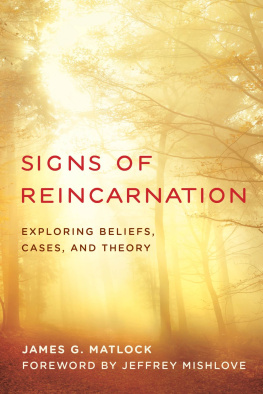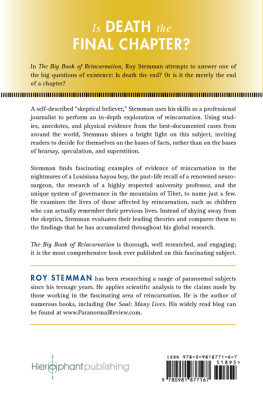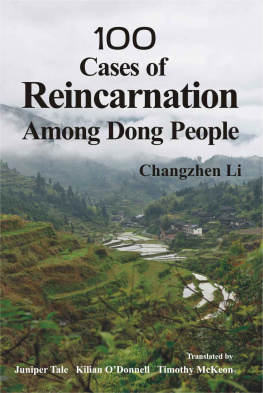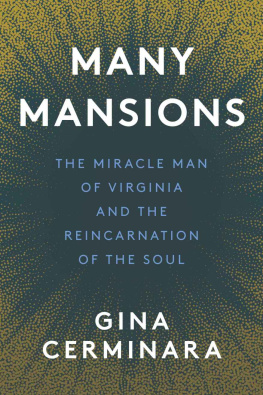Signs of Reincarnation
Signs of Reincarnation
Exploring Beliefs, Cases,
and Theory
James G. Matlock
Foreword by Jeffrey Mishlove
ROWMAN & LITTLEFIELD
Lanham Boulder New York London
Published by Rowman & Littlefield
An imprint of The Rowman & Littlefield Publishing Group, Inc.
4501 Forbes Boulevard, Suite 200, Lanham, Maryland 20706
www.rowman.com
6 Tinworth Street, London SE11 5AL, United Kingdom
Copyright 2019 by The Rowman & Littlefield Publishing Group, Inc.
All rights reserved . No part of this book may be reproduced in any form or by any electronic or mechanical means, including information storage and retrieval systems, without written permission from the publisher, except by a reviewer who may quote passages in a review.
British Library Cataloguing in Publication Information Available
Library of Congress Cataloging-in-Publication Data
Names: Matlock, James G., 1954- author.
Title: Signs of reincarnation : exploring beliefs, cases, and theory / James G. Matlock ; foreword by Jeffrey Mishlove.
Description: Lanham : Rowman & Littlefield, [2019] | Includes bibliographical references and index.
Identifiers: LCCN 2019005826 (print) | LCCN 2019017045 (ebook) | ISBN 9781538124802 (electronic) | ISBN 9781538124819 (cloth : alk. paper) | ISBN 9781538124796 (pbk : alk. paper)
Subjects: LCSH: Reincarnation.
Classification: LCC BL515 (ebook) | LCC BL515 .M333 2019 (print) | DDC 133.901/35dc23
LC record available at https://lccn.loc.gov/2019005826
 The paper used in this publication meets the minimum requirements of American National Standard for Information SciencesPermanence of Paper for Printed Library Materials, ANSI/NISO Z39.48-1992.
The paper used in this publication meets the minimum requirements of American National Standard for Information SciencesPermanence of Paper for Printed Library Materials, ANSI/NISO Z39.48-1992.
Printed in the United States of America
For Cristina
Contents
Jeffrey Mishlove
From the conventional, materialist point of view, a human life could be thought of as analogous to a piece of string. One end represents your birth. Then the string meanders around until you reach the other endand your life is terminated. Once you leave this physical plane of existence, there is no more string. From the perspective of reincarnation as an empirical fact, life seems more like a circle or even a spiral. The string doesnt end with death. Nor does it begin with birth. In fact, reincarnation is sometimes likened to a wheel. Around and around we go, hopefully learning a bit more each time. Where the string begins and where it ends are questions subject to further inquiry.
The very idea of reincarnation, or rebirth, has powerful archetypal implicationsfar beyond the metaphoric differences between a piece of string and a spiral with no obvious beginning or end. It can shake one to ones core.
I remember quite distinctly the very first time I was introduced to this notion. I was a ten-year-old child, in the fourth grade, when my classmate presented a book report on Morey Bernsteins (1956) The Search for Bridey Murphy an international best seller about a case of past-life hypnotic regression. At the moment I heard my classmate saying that this book explores the possibility that we have lived other lives before we were born, I felt an electrical shiver running up and down my spine. For me, moments like that seem to reflect a deep inner knowing or remembering.
To be clear, in spite of their importance to many individuals (including myself), neither past-life hypnotic regressions nor electrical shivers running up and down the spine are regarded as major signifiers of reincarnation in this bookbased as it is on an analysis of the empirical data derived from a collection of more than seventeen hundred cases in which young children have reported veridical memories of previous lives.
Here, anthropologist Dr. James Matlock proposes that other signs do exist and have been known to both ancient and indigenous peoples throughout the world. Our modern, Western culture has lost this knowledge. But now, thanks to the diligent research of the late Dr. Ian Stevenson and the team that remains at the University of Virginia, along with a few others, this knowledge is being recovered. Matlock, an independent scholar associated with the Parapsychology Foundation, is at the forefront of that recovery process. To my knowledge, this book is unique. It bears the distinction of being the first college-level text to thoroughly review and evaluate the many empirical signs and pointers that relate to the ostensible process of reincarnation. It is interesting to note, for example, that over half of the time when children report memories of previous lives, those memories entail a violent death.
In order to understand the reincarnation process, it is helpful if we are willing to think of ourselves as reincarnation investigators. Matlock understands this because in the very first chapter he will be taking us along with him on a case study, visiting Bartlesville, Oklahoma. There we will come to know a young child, Rylann OBannion, born in 2008, who appears to have hazy yet uncanny memories concerning the tragic death of eleven-year-old Jennifer Schultz, who was sitting on a swing in the carport of her familys home in Kenner, Louisiana, just outside of New Orleans, speaking on the phone, when Pan Am Flight 759 faltered upon takeoff and crashed into the house.
Matlock will take us to the neighborhood where Jennifer Schultz was killed. He will even present a photo of the Schultzs ruined house on Fairway Street.
As I read through Matlocks manuscript, in preparation for writing this foreword, I could not help but notice a remarkable coincidence: I have been to that very location on Fairway Street in Kenner, Louisiana, before! Like many people, I suppose I am prone to push bizarre coincidences out of my mind. Nevertheless, my experience as a parapsychological investigator, as well as a psychotherapist with Jungian leanings, has shown me that the pursuit of such striking coincidences can lead to unexpected insights. The story of how my own life has surprisingly intersected (albeit only geographically) with Matlocks case investigation of Rylann OBannions previous-life memories highlights, in this case, the difficulties faced by researchers, such as Matlock, who maintain that seemingly paranormal events are deserving of scientific investigation.
In 1983, I was hired by my late friend William Jennings, attorney for the International Airline Passengers Association, to organize a press conference in New Orleans in conjunction with the National Transportation Safety Board hearing about the tragic crash of Pan Am 759. The Association wished to promote the notion that the accident was caused not only by wind shear (the official explanation), but also by rain. The press conference was a success and was covered on national television. While on that trip, Jennings and I visited the crash site where Jennifer Schultz and 152 others lost their lives. That is the simple, prosaic basis for the coincidence. But, there is much more to the story that bears on the status of parapsychology as a legitimate scientific endeavor.
William Jennings was an unusual man, who had come into my life in a weird way. Years earlier, I received a phone call from him, out of the blue, introducing himself as Captain Rainbow. He told me that he was the inventor of Captain Rainbows Laser Visors and that he had plans to sell one to every person in China. He explained that the diffraction grating plastic visors turned everything into rainbow colors and that this had the effect of opening up the chakras.
When I told my wife, Janelle, about this strange phone call, her responseto my admiration and delightwas lets invite him over for lunch. That was the beginning of a friendship that lasted for decades. A few years later, in 1980, I received my doctoral degree in parapsychology from the University of California, Berkeley. To this day, my doctoral diploma remains the only one granted by an accredited university anywhere in the world that actually names the discipline of Parapsychology. So, inevitably, I became a target for individuals who were hostile to the field. After graduating, I was publicly libeled in a major national magazine and found thatafter a decade in graduate schoolI was, essentially, unemployable in parapsychology (where few employment opportunities existed in the first place).
Next page












 The paper used in this publication meets the minimum requirements of American National Standard for Information SciencesPermanence of Paper for Printed Library Materials, ANSI/NISO Z39.48-1992.
The paper used in this publication meets the minimum requirements of American National Standard for Information SciencesPermanence of Paper for Printed Library Materials, ANSI/NISO Z39.48-1992.